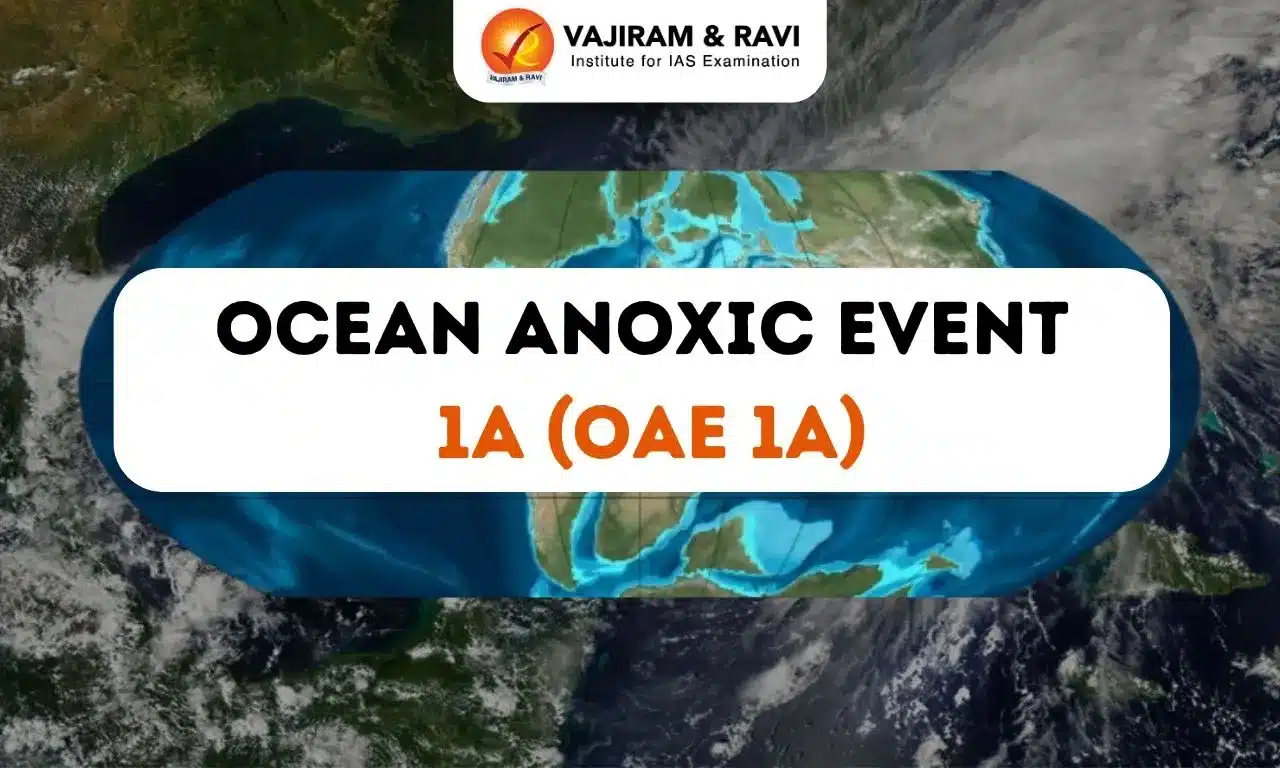What is Ocean Anoxic Event 1a (OAE 1a)?
- Definition: OAE 1a occurred during the Cretaceous Period (145–66 million years ago), marking a time when Earth’s oceans became depleted of oxygen. This led to severe disruptions in marine ecosystems.
- Causes: Triggered by massive volcanic eruptions, which released large amounts of carbon dioxide (CO₂), resulting in global warming and oxygen depletion in the oceans.
- These conditions created anoxic marine basins, where oxygen levels were nearly absent.
- Impacts: The interaction of CO₂ and seawater formed carbonic acid, dissolving marine organisms’ shells and reducing oxygen levels.
- This resulted in the extinction of several marine species, particularly plankton, and led to the formation of black shales, organic carbon-rich layers preserved in geological records.
- Anoxic marine basins: Bodies of water, often in deep ocean regions, where oxygen levels are extremely low or absent.
- Characteristics: Favor the survival of specialized microbes and fungi while inhibiting most aerobic life forms.
- Carbon Sequestration: Low oxygen levels slow the decomposition of organic matter, aiding in long-term carbon sequestration, which helps reduce atmospheric CO₂ levels.
- Examples: Black Sea, Cariaco Basin (Caribbean Sea), and Orca Basin (Gulf of Mexico).
Key Highlights of the Recent Study
- Timing: The event began 119.5 million years ago, confirmed through isotopic analysis of volcanic tuffs from Japan’s Hokkaido Island.
- OAE 1a lasted approximately 1.1 million years, indicating the extended recovery period for oceans after CO₂-driven warming and anoxia.
- Volcanic activity: Linked to massive volcanic eruptions, such as the Ontong Java Nui complex, which released significant CO₂ into the atmosphere and oceans.
- Modern relevance: Highlights parallels between ancient volcanic CO₂ emissions and current human-induced warming.
- Warns that rapid modern warming could trigger similar disruptions in marine ecosystems and potentially lead to a Holocene extinction event.
Q1) What is the National Institute of Ocean Technology (NIOT)?
NIOT was established in November 1993 as an autonomous society under the Ministry of Earth Sciences, Government of India. NIOT is managed by a Governing Council and the Director is the head of the Institute.
Source: PHYS
Last updated on January, 2026
→ Check out the latest UPSC Syllabus 2026 here.
→ Join Vajiram & Ravi’s Interview Guidance Programme for expert help to crack your final UPSC stage.
→ UPSC Mains Result 2025 is now out.
→ UPSC Notification 2026 is scheduled to be released on January 14, 2026.
→ UPSC Calendar 2026 has been released.
→ UPSC Prelims 2026 will be conducted on 24th May, 2026 & UPSC Mains 2026 will be conducted on 21st August 2026.
→ The UPSC Selection Process is of 3 stages-Prelims, Mains and Interview.
→ Prepare effectively with Vajiram & Ravi’s UPSC Prelims Test Series 2026 featuring full-length mock tests, detailed solutions, and performance analysis.
→ Enroll in Vajiram & Ravi’s UPSC Mains Test Series 2026 for structured answer writing practice, expert evaluation, and exam-oriented feedback.
→ Join Vajiram & Ravi’s Best UPSC Mentorship Program for personalized guidance, strategy planning, and one-to-one support from experienced mentors.
→ UPSC Result 2024 is released with latest UPSC Marksheet 2024. Check Now!
→ UPSC Toppers List 2024 is released now. Shakti Dubey is UPSC AIR 1 2024 Topper.
→ Also check Best UPSC Coaching in India

















